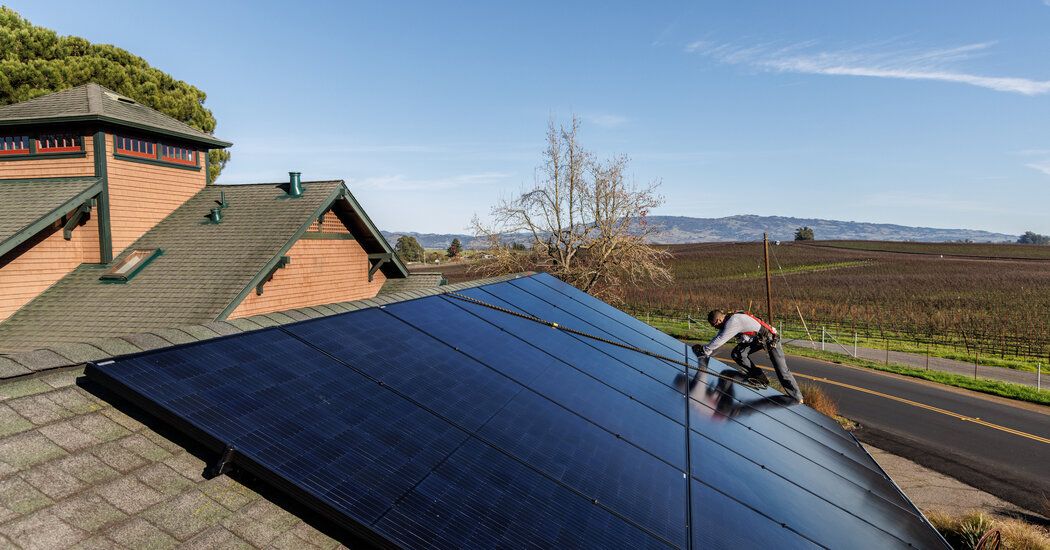California has long championed renewable energy, but a change in state policy last year led to a sharp decline in residential rooftop solar installation in the state.
Thousands of businesses, including installers, manufacturers and distributors, are reeling from the new policy, which went into effect in April and greatly reduced incentives that had encouraged homeowners to install solar panels. Since the change, sales of rooftop solar installations in California fell as much as 85 percent in some months of 2023 from a year earlier, according to a report from Ohm Analytics, a research company that tracks the solar market. Industry groups project that installations in the state will fall more than 40 percent this year and continue to decline through 2028.
“Solar installations are doing extremely well,” said Michael Wara, a senior researcher at the Stanford Woods Institute for the Environment. “What is happening now is a painful adaptation process.”
Construct Sun, a solar installation company based in Reno, Nevada, stopped doing business in California after its sales dried up four months after the policy began; Executives said the company was now focusing its efforts on Florida, North Carolina and Ohio.
“I had a very dismal pipeline and I had to make the decision to shut it down in California,” said Thomas Devine, executive vice president of operations at Construct Sun. He added that the state's rooftop policies undermine his goal of effectively eliminating greenhouse gas emissions by 2045. “These competing policies are crazy,” he said.
State officials bristle at the idea that California is undervaluing renewable energy and have defended the policy change, which reduced by 75 percent the value of credits homeowners with new installations receive for the energy they send to network. They have argued that the old rules, which still apply to systems installed before April, offered too generous a subsidy, helping mostly wealthy homeowners. As a result, low-income people who couldn't afford the panels had to bear more of the cost of maintaining the state's electrical system.
“California has done more for the solar industry than any other state in the nation by providing billions in rebates and incentives since 2006,” the state's Public Utilities Commission, which oversees rooftop solar and utilities, said in a statement. investor-owned utilities.
States across the country have struggled with how to compensate consumers for the electricity their rooftop solar systems send to the grid. And officials have often looked to California for guidance.
Many states, including California before it changed its policy, generally allow homeowners to receive credits that are roughly equivalent to the retail electric rate for the energy their systems send to the grid. This has never sat well with most utility companies, who argue that offering homeowners a one-for-one credit for solar power overstates the value of that electricity. Utilities say they could buy electricity for much less on the wholesale market or by producing it themselves.
Overall, renewable energy is growing and now provides more than a fifth of the country's electricity. In California, renewable sources produce more than a third of electricity.
But the growth of carbon-free sources has become bumpy as regulators, utilities, consumers and renewable energy companies fight over their financial benefits. They are also trying to find ways to not only add equipment that can generate electricity but also batteries that can store it because solar and wind power are intermittent.
California officials note that even as they reduced compensation for rooftop solar, they offered residents more incentives to install batteries. Batteries, they say, can help supply power to the grid when it's needed most, not just in the middle of the day, when California typically has a surplus. The devices can also provide power during blackouts.
“Today, California has a huge need for more energy storage and our state must transition incentives toward storage technologies to support reliability, allow polluting gas facilities to retire, and relieve pressure on electric rates,” said David Hochschild, chairman of the California Energy Commission. , which broadly oversees the energy industry.
Since regulators put the new rooftop solar policy into effect, the percentage of consumers purchasing battery-powered solar panels has risen to 50 percent, from just 5 percent before the changes.
But batteries are expensive, especially in a time of high interest rates. Without federal tax incentives, a solar and battery system costs $33,700 on average, compared to $22,700 for systems that don't include batteries, according to EnergySage, a shopping site that compares rooftop solar panels.
Installers and homeowners say investing in rooftop solar systems is difficult to justify financially without access to adequate electricity credits. California's decision to reduce the incentive has increased the amount of time it takes a solar system to pay for itself to at least eight years, up from about five years.
The nation's largest residential solar company, San Francisco-based Sunrun, cut about 2,000 jobs after California regulators reduced incentives for rooftops.
“It's very unfortunate from the perspective that we're in a time where the planet is on fire,” said Mary Powell, Sunrun's chief executive. But she added that because of the size of her company and its nationwide operations, it has been able to absorb much of the impact.
Other companies face greater challenges.
About four years ago, Amy Atchley founded Amy's Roofing and Solar. Before California changed its policy, solar energy sales drove more than 55 percent of her business, which she runs with her husband, Brian, in Petaluma, north of San Francisco. Since the policy went into effect, solar sales have fallen to 45 percent. To reduce costs, Ella Atchley said she typically recommended that her clients install solar panels when they were also replacing their roofs.
“California should do everything in our power to become a clean energy state,” Atchley said. “But the momentum has stopped.”
Offering energy credits to homeowners with rooftop solar panels was a central component of legislation, passed when Arnold Schwarzenegger was governor, that aimed to add a million rooftop solar panels, reduce electric bills and fight change. climate. The state met its roofing goal in 2019 and now has panels on 1.8 million roofs.
Some solar energy experts say California's new policy is flawed because it doesn't adequately take into account the environmental value that rooftop solar panels provide.
“Solar energy is valued the same as fossil fuel energy, so that doesn't make sense,” said Yogi Goswami, an engineering professor and director of the Clean Energy Research Center at the University of South Florida. “We should have given some value to the environmental factor.”
By cutting the incentive at a time when the world needs more clean energy, “they're making it a lot harder,” he added.
Nationally, rooftop solar grew about 13 percent last year, but this year could decline by 11.5 percent, according to the Solar Energy Industries Association, which attributes the drop primarily to changing U.S. solar energy policy. California.
Pacific Gas & Electric, California's largest utility, said rooftop solar connections to its system hit a record level last year, up 20 percent from 2022. This may be because many homeowners They rushed to install solar panels before the new policy went into effect in April. .
“At PG&E, we recognize the important role that rooftop solar plays in California's clean energy future,” Carla Peterman, PG&E executive vice president of corporate affairs and former state utility regulator, said in a statement. “We are proud to have interconnected more than 750,000 private solar customers, more than any other U.S. utility.”
Rooftop solar advocates have asked the courts to intervene, and others have pressured state regulators and lawmakers to change course or risk losing more jobs and businesses.
“The question is, who survives this?” said Bernadette Del Chiaro, executive director of the California Solar Energy and Storage Association. “How many companies manage to overcome this transition?”
Some energy experts said rooftop solar could regain some of its financial appeal as California raises electricity rates, already among the highest in the country. The Public Utilities Commission recently approved higher rates for customers of investor-owned utilities Pacific Gas & Electric, Southern California Edison and San Diego Gas & Electric.
PG&E customers will soon pay about 45 cents per kilowatt-hour, up from about 35 cents. That works out to about $250 a month for 571 kilowatt-hours, the average usage in California homes. By comparison, the national average retail electricity rate was 16.2 cents in October.
More Californians could install solar panels and batteries not to earn credits for the excess energy the panels produce, but simply to reduce their dependence on utilities. But that option would primarily be an advantage that wealthy homeowners could take advantage of rather than those with limited means, Stanford's Wara said. He added: “There is a huge affordability challenge for California electricity.”









